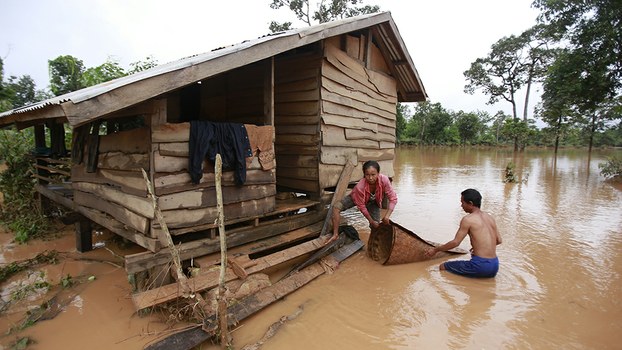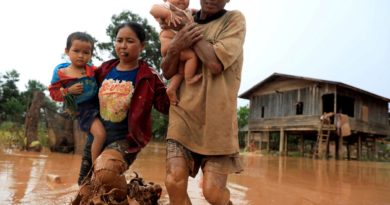Lao Dam Collapse Caused by Heavy Rains, Faulty Construction: Minister
Source: RFA
A high-ranking Lao official suggested Thursday that a dam collapse earlier this week in Attapeu province was the result of faulty construction and said the project’s developer should be held accountable, as the death toll from flooding has reached 30, with more than 20 hospitalized for injuries.
On the night of July 23, water poured over a saddle dam at the Xe Pian Xe Namnoy hydropower project in Attapeu, sweeping away homes and causing severe flooding in up to 12 villages downstream.
Despite early warnings of a possible breach due to heavy rainfall, many were left behind in their homes when “Saddle Dam D” collapsed, prompting questions about the evacuation process and what was known about the dam’s structural integrity before the disaster struck.
On Thursday, Minister of Energy and Mines Khammany Inthirath told RFA’s Lao Service that the burst was caused by “heavy rainfall” and “construction technique.”
“From July 21-23, there was heavy rainfall in the area and this caused water in the main reservoir to increase rapidly,” Khammany said.
“It overloaded Saddle Dam D, which has a dike constructed of soil and stone, and combined with the rainfall, it finally burst on July 23,” he said.
“The construction technique is one of the main causes of the collapse, because they built the dike … with soil and stones.”
The U.S. $1.02 billion Xe Pian Xe Namnoy hydropower project involves Lao, Thai and South Korean partners and consists of two main dams and five subsidiary dams.
On Wednesday, the project’s main partner, South Korea’s SK Engineering & Construction, said in a statement that the firm had discovered fractures in the dam 24 hours before the collapse, and had “immediately alerted the authorities and began evacuating villagers downstream.”
Khammany told RFA that the saddle dam was “91 percent complete” and should only have been filled with water incrementally, but said the heavy rainfall had inundated the structure.
“We can rule out technical fraud,” he said, adding that construction had proceeded according to “international standards.”
When asked whether the developers had prepared for increased water capacity during the annual rainy season, the minister said that they had, but the amount of rainfall had surpassed expectations.
“Some years it rains little and others it rains a lot—each storm is different in intensity,” he said.
“But I am fairly certain that the construction technique for the dam was poor, which led to a collapse during heavy rainfall.”
Earlier on Thursday, Khammany told reporters that the construction company should take full responsibility for the incident.
“I confirm that compensation will be given according to the concession agreement,” he said.
“Everything that happened is related to the dam construction, so the developer [Xe Pian Xe Namnoy Power Co. Ltd] must be held 100 percent accountable,” he added, without providing further details.
Death toll rise
Khammany’s assessment came as an official with the taskforce committee overseeing rescue operations in the region confirmed to RFA that the death toll from the collapse had risen to 30 on Thursday, with more than 20 people hospitalized with related injuries, as rain continued to blanket the area.
On Wednesday, Laos’ Prime Minister Thonglun Sisoulit said in a televised news conference that 26 people had been confirmed dead and 131 were missing, though officials had earlier suggested that “hundreds” were missing in the aftermath of the collapse.
The taskforce committee official, who spoke on condition of anonymity Thursday, said that the number of people living in villages along the Sekong River who may be impacted by the collapse could reach as many as 8,000.
More than 600 villagers remain stranded in floodwaters, as rescue teams have had difficulty accessing certain areas of the remote region, he said, adding that efforts will be further hampered by mud and debris left behind after the waters recede.
Vietnam has sent military and medical personnel to assist in rescue efforts, while Thailand has pledged around U.S. $150,000 in aid. Around a dozen Chinese rescue workers joined efforts on Thursday.
Cambodians affected
Along the Sekong River in downstream areas of Cambodia’s Stung Treng province, local authorities told RFA’s Khmer Service that around 5,000 flood victims had been relocated to four safe communes in the region, and were being provided food and medical attention.
Provincial spokesman Men Kong said authorities were focusing on assisting victims and would later investigate whether to hold Lao authorities responsible for compensation related to inundation from the flooding, which he suggested could continue into next month.
Cambodia’s Ministry of Water Resources and Meteorology said Thursday that the water level of the Sekong River is currently above 11 meters (36 feet) and is likely to reach 12 meters (39 feet) before it recedes. The rise of the river is expected to damage roads, housing, and other infrastructure in Stung Treng, it said.
A flood victim in Stung Treng named Le Chy told RFA he is concerned that the flooding will destroy hundreds of hectares (1 hectare = 2.3 acres) of farmland and plantations, and seriously impact area residents if it continues.
Dam-building spree
Laos and many other Asian countries are on a dam-building spree as they try to harness the power of the Mekong and other rivers.
While the Lao government sees power generation as a way to boost the country’s economy, the projects are still controversial for their environmental impact and financial arrangements.
According to International Rivers, an environmental advocacy group, the current Lao hydropower development plan includes 72 new large dams, 12 of which are under construction and nearly 25 are in advanced planning stages.
The Lao government says the dams will help pay for anti-poverty and other social welfare programs, but International Rivers asserts that much of the power generated by Laos is sold to neighboring countries and then resold to Laos at higher rates.
Reported by RFA’s Lao Service and RFA’s Khmer Service. Translated from Lao by Ounkeo Souksavanh and Samean Yun. Written in English by Joshua Lipes.



